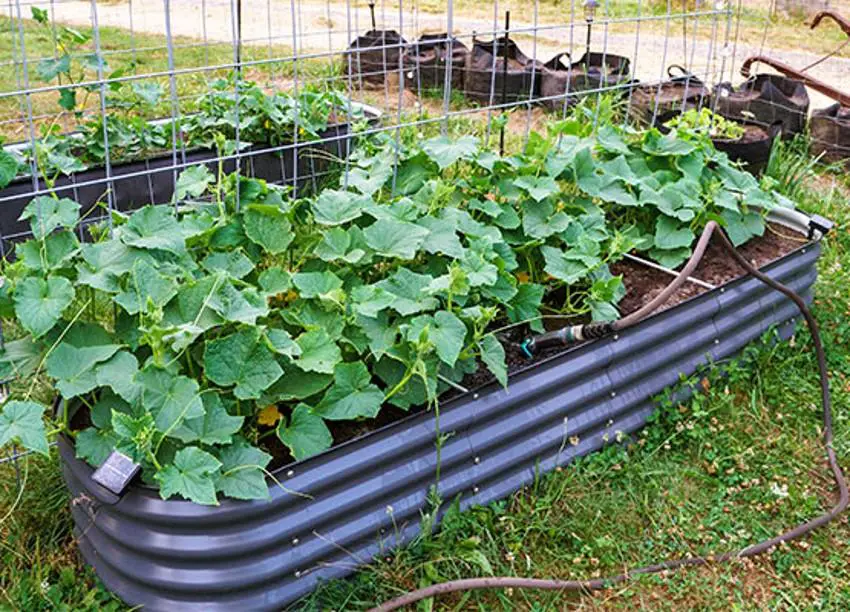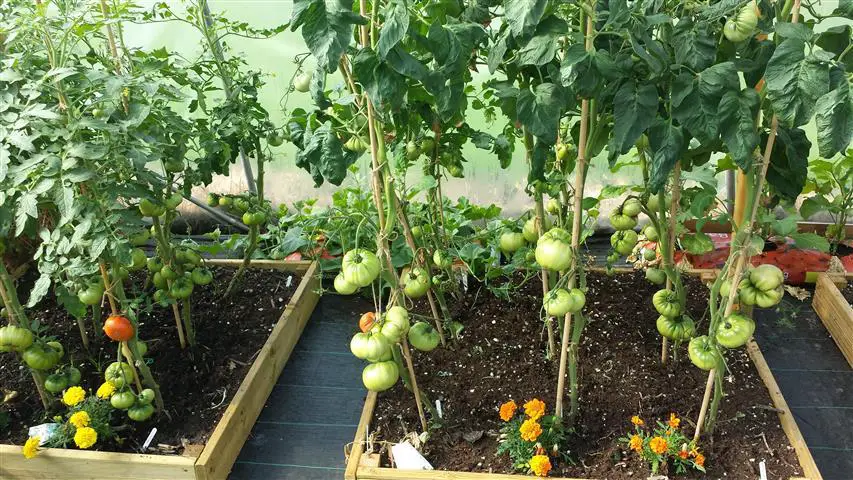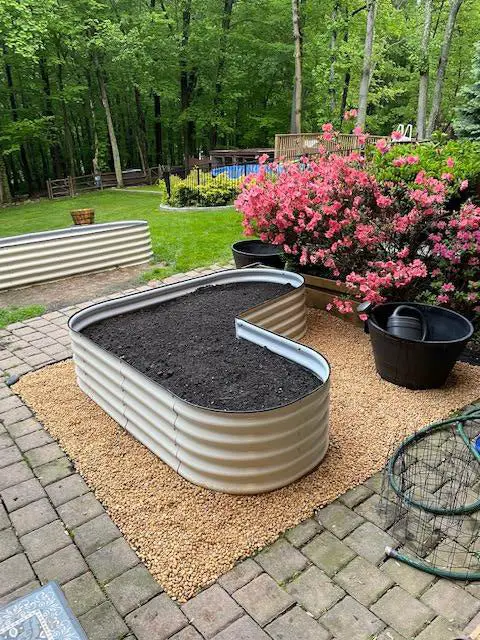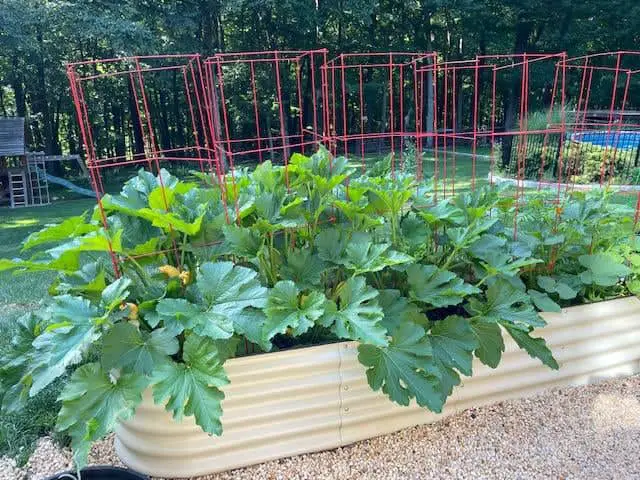Raised bed gardening has become increasingly popular in recent years. As it offers a convenient and accessible way to grow fresh fruits, vegetables, and herbs.
Whether you’re a seasoned gardener or starting out. Raised bed gardening is a great way to get involved and enjoy growing your own produce.
In this post, We will walk you through everything you need to know to get started with raised bed gardening. We’ll cover topics such as:
- Choosing the right location and size for your raised bed garden
- Building or purchasing a raised bed
- Preparing the soil for planting
- Planting your garden
- Caring for your garden
- Harvesting your crops
Why Choose Raised Bed Gardening?
Metal Garden Beds UK
There are many reasons why raised bed gardening is a great option for both beginners and experienced gardeners:
- Improved soil health: Raised beds allow you to control the soil composition. Which can lead to better drainage, aeration, and nutrient availability for your plants.
- Reduced soil compaction. Because raised beds are elevated, they are less likely to be compacted by foot traffic. Which can damage root systems and reduce air circulation.
- Ease of access. Raised beds are above ground level, making them easier to access for people of all ages and abilities.
- Control over pests and diseases. Raised beds can be easier to protect from pests and diseases than traditional gardens. As the soil is less likely to be contaminated with harmful organisms.
- Versatility: Raised beds can be used to grow a wide variety of plants, including vegetables, fruits, herbs, and flowers.
- Elevated appearance: Raised beds can add a touch of visual interest to your yard or garden.
Choosing the Right Location and Size
The first step to successful raised bed gardening is to choose the right location for your beds. Ideally, your beds should be located in a sunny spot with well-drained soil. Avoid planting in areas that are prone to flooding or shade from buildings or overhanging trees.
As for size, the size of your raised beds will depend on the amount of space you have available and the amount of produce you want to grow.
A good rule of thumb is to start with a bed that is at least 4 feet by 4 feet. This is popular with Square Foot Gardening enthusiasts.
Depth can vary between 6 inches to 24 inches and over. It depends on the type of plant you wish to grow, and the root depth in particular.
Building or Purchasing a Raised Bed
There are many different ways to build a raised bed. You can use wood, metal, or concrete blocks. If you’re building your own bed, make sure to use materials that are durable and water-resistant.
If you don’t have the time or skills to build your own bed, there are many pre-made or DIY raised bed kits available for purchase. These kits are typically made from wood or steel and come in a variety of sizes.
Preparing the Soil
Before you start planting, you’ll need to prepare the soil in your raised beds. This includes adding organic matter such as compost or aged manure to improve drainage and nutrient content. You should also amend the soil with a balanced fertilizer.
Soil in a raised garden bed should be light and friable. Easy to work over with simple hand tools. For this reason a mix of soil, compost, and vermiculite in equal quantities does well for most vegetables.
Planting Your Raised Bed
Once your soil is ready, you can start planting your garden. Choose a variety of vegetables, fruits, herbs, and flowers that will grow well in your climate.
When planting, be sure to follow the instructions on the seed packet or plant label. Pay attention to plant spacing and depth requirements.
Spacing in a raised bed is different from a traditional garden. Plants can be grown closer together because of the nutrient-rich soil.
Planting Your Garden
Now that your soil is ready and you’ve chosen your plants, it’s time to start planting!
Planting in Spring
Spring is the best time to plant most vegetables, herbs, and flowers in raised beds. The soil is warming up, and there is plenty of moisture available. To plant in spring, follow these steps:
- Dig a hole that is twice as wide as the root ball of your plant.
- Hold plant gently by the leaves. Add the plant then re-fill the hole and press down gently but firmly around the plant.
- Water thoroughly.
To plant from seed. Follow the instructions on the packet for depth and spread of seeds.
Here are some vegetables that are good to plant in spring in a raised bed garden:
Planting in Summer
Summer is a good time to plant some vegetables, herbs, and flowers that prefer warmer weather.
Here are some vegetables that are good to plant in summer in a raised bed garden:
- Basil
- Bell peppers
- Cabbage
- Cauliflower
- Corn
- Green beans
- Okra
- Peppers
- Squash
Planting in Fall
Early Fall is a good time to plant vegetables, herbs, and flowers that can withstand cooler temperatures. To plant in fall, follow these steps:
- Choose a location that receives partial shade.
- Water your plants regularly, but less frequently than in summer.
- Stop fertilizing your plants once the days start to get shorter.
Here are some cool climate vegetables that are good to plant in fall in a raised bed garden:
- Broccoli
- Brussels sprouts
- Collard greens
- Kale
- Lettuce
- Spinach
- Swiss chard
Planting Herbs
Herbs are a great addition to any raised bed garden. They are easy to grow and can be used fresh or dried.
Here are some herbs that are good to plant in a raised bed garden:
- Basil
- Chives
- Dill
- Lavender
- Mint
- Oregano
- Parsley
- Rosemary
- Thyme
Perfect Ground Temperatures and Climates for Different Vegetables
When choosing vegetables to plant in your raised bed garden. Consider the ideal ground temperatures and climate for each type of plant. This will help you ensure that your vegetables have the best possible chance of growing well.
Cool-Season Vegetables
- Asparagus: Asparagus prefers cool, moist soil. The ideal soil temperature for planting asparagus is between 50 and 60 degrees Fahrenheit. Asparagus can be grown in USDA hardiness zones 3 through 9.
- Broccoli: Broccoli prefers cool, well-drained soil with a pH of 6.5 to 7.0. The ideal soil temperature for planting broccoli is between 45 and 55 degrees Fahrenheit. Broccoli can be grown in USDA hardiness zones 2 through 10.
- Beetroot thrives in well-drained, loose soil. It prefers slightly acidic to neutral soil pH. Plant beetroot in full sun for optimal growth. Suitable for USDA hardiness zones 2 through 11.
- Carrots: Carrots prefer cool, sandy soil with a pH of 6.0 to 6.8. The ideal soil temperature for planting carrots is between 45 and 55 degrees Fahrenheit. Carrots can be grown in USDA hardiness zones 3 through 10.
- Lettuce: Lettuce prefers cool, loose soil with a pH of 6.0 to 6.8. The ideal soil temperature for planting lettuce is between 45 and 60 degrees Fahrenheit. Lettuce can be grown in USDA hardiness zones 2 through 11.
- Spinach: Spinach prefers cool, well-drained soil with a pH of 6.0 to 7.5. The ideal soil temperature for planting spinach is between 45 and 60 degrees Fahrenheit. Spinach can be grown in USDA hardiness zones 3 through 10.
- Swiss Chard: Swiss chard prefers cool, well-drained soil with a pH of 6.5 to 7.0. The ideal soil temperature for planting Swiss chard is between 45 and 60 degrees Fahrenheit. Swiss chard can be grown in USDA hardiness zones 3 through 10.
Warm-Season Vegetables
- Bell Peppers: These peppers prefer warm, well-drained soil with a pH of 6.5 to 7.0. The ideal soil temperature for planting bell peppers is between 60 and 80 degrees Fahrenheit. Bell peppers can be grown in USDA hardiness zones 2 through 10.
- Cucumbers: Cucumbers prefer warm, fertile soil with a pH of 5.5 to 7.0. The ideal soil temperature for planting cucumbers is between 60 and 95 degrees Fahrenheit. Cucumbers can be grown in USDA hardiness zones 3 through 10.
- Tomatoes: These prefer warm, well-drained soil with a pH of 6.0 to 6.8. The ideal soil temperature for planting tomatoes is between 60 and 95 degrees Fahrenheit. Tomatoes can be grown in USDA hardiness zones 2 through 11.
- Peas: Prefer cool, well-drained soil with a pH of 6.0 to 7.0. The ideal soil temperature for planting peas is between 45 and 65 degrees Fahrenheit. Peas can be grown in USDA hardiness zones 2 through 11.
- Pumpkins: Prefer warm, well-drained soil with a pH of 6.5 to 7.0. The ideal soil temperature for planting pumpkins is between 60 and 85 degrees Fahrenheit. Pumpkins can be grown in USDA hardiness zones 3 through 10.
- Squash: Squash prefers warm, well-drained soil with a pH of 6.0 to 7.0. The ideal soil temperature for planting squash is between 60 and 85 degrees Fahrenheit. Squash can be grown in USDA hardiness zones 3 through 10.
By choosing vegetables that are well-suited to your climate and soil conditions. You can increase your chances of growing a bountiful harvest.
Caring for Your Raised Bed Garden
Raised bed gardens require regular watering, weeding, and pest control. To keep your plants healthy, water them deeply and infrequently.
Weeding is much easier in a raised bed. But it has to be done nevertheless! Weed regularly to prevent competition for nutrients and sunlight. Monitor for pests and diseases. Then take action if necessary.
Additional Tips
- Mulch around your plants to help retain moisture, suppress weeds, and regulate soil temperature.
- Use a drip irrigation system to save water and reduce the risk of overwatering.
- Consider using a floating row cover to protect your plants from pests and diseases.
- Monitor your plants for signs of stress, such as wilting or yellowing leaves.
Volumes of material needed to fill Raised Beds
| SIZE | 6 INS DEEP | 12 INS DEEP | 18 INS DEEP | 24 INS DEEP | 30 INS DEEP |
| 4 X 4 | 8 cu ft | 16 cu ft | 24 cu ft | 30 cu ft | 36 cu ft |
| 6 X 4 | 12 | 24 | 36 | 48 | 60 |
| 8 X 4 | 16 | 32 | 48 | 60 | 72 |
| 4 X 2 | 4 | 8 | 12 | 16 | 20 |
| 8 X 2 | 8 | 16 | 24 | 30 | 36 |





